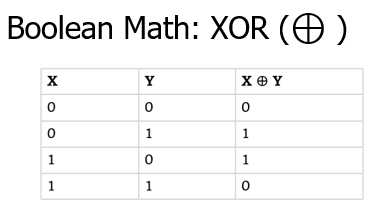Hello everyone. We’ve got another Boolean math session to look over today. Our focus this time will be on the XOR logic. The XOR stands for exclusive OR, and we will go over the details of what that means in just a moment.
For those who are less familiar with Boolean logic, here is a short review of what it is and how it works. Basically, Boolean math is based on the binary system, and since it’s using binary there are only two values that exist (i.e. 1 or 0). When working with Boolean math, a 1 is equal to a True condition, and a 0 is equal to a False condition. This usually comes into play when something is either on or off, true or false.
An interesting symbol is used to represent the XOR logic, and it looks like this, ⊕ . If you’re wondering how to create this symbol in a word doc, then you can use an ASCII code. I tend to refer to them as alt-codes since you would hold down the ALT key and type in the numbers 8853. Different number combinations produce different symbols, but if the word file you’re in supports it, then ALT-8853 will give you the correct symbol for this Boolean operation.
So, let’s start by defining the XOR operation. The XOR operation checks to see if one of the two values presented is True (1). If one, and only one, of the values is True (1), then the final result is also True (1). Otherwise, the result is False (0).
This is different from what we saw in the previous OR logic. The OR logic states that either one or both values are True, then the result would be True. Here, as we are applying the XOR logic, the result is True (1) when one, and only one of the values is set to 1.
Below is the truth table used for the XOR logic. This helps to map out all the possible combinations of 0 and 1 so that we can visualize the results of applying the XOR logic.

So, let’s look at an example problem and use the XOR operational logic to find the solution.
Example Boolean Problem:
X: 0 1 1 0 0 1 0 1
Y: 1 0 1 0 0 1 1 0
_______________________
X ⊕ Y:
Whenever you see a problem like this, the very first thing you always do is to check the Boolean symbol used, so that you know which type of logic needs to be applied. In the example shown above, we see that the ( ⊕ ) is being used, so we know to use the XOR logic.
Next, we compare the X and Y values in each column. Starting with the first column, we would reference the XOR logic and ask the question, “Is one, and only one of the values equal to 1?”. If so, then the result will be 1, otherwise, the result will be 0.

In the same way, continue to compare the values in each column of the problem and apply the XOR logic to each pair of X/Y values. When you’re done, the final answer should look like this:

Take some time to do some additional practice problems and solve them using the XOR logic. Check for the XOR symbol, and then apply the XOR logic. Hopefully this has been helpful for identifying how the XOR logic works and to help prepare you for any similar questions you may face on your CISSP exam.
This has been a quick look at the XOR Boolean logic. There is an audio/video version of this material on youtube, for anyone who prefers that format. If you’re interested in security fundamentals, we have a Professionally Evil Fundamentals (PEF) channel that covers a variety of technology topics. We also answer general basic questions in our Knowledge Center. Finally, if you’re looking for a penetration test, training for your organization, or just have general security questions please Contact Us.
